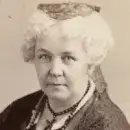
Elizabeth Cady Stanton
Elizabeth Cady Stanton was a leader in the women’s rights movement who, in 1848, formulated the first organized demand for woman suffrage in the United States: The Declaration of Sentiments. She was the main force behind the 1848 Seneca Falls Convention, the first convention to be called for the purpose of discussing women’s rights.
Born in Johnstown, New York, Stanton was educated at Johnstown Academy and Troy Female Seminary (diploma, 1832). In 1840, she attended the World’s Anti-Slavery Convention in London, where she was outraged by the denial of recognition to women delegates, most notably Lucretia C. Mott. She became a frequent speaker on the subjects of women’s rights, temperance, and abolition, and organized efforts to secure passage of a bill granting married women property rights by the New York legislature in 1848. That same year, Stanton and Mott issued a call for a women’s rights convention to meet in Seneca Falls and Rochester, New York. In the opening speech at the convention, Stanton introduced her Declaration of Sentiments, which called for extensive reforms and effectively launched the American women’s rights movement.
Beginning in 1851, she worked closely with Susan B. Anthony, a partnership that lasted fifty years, as they planned campaigns, spoke before federal and state legislative bodies, and addressed public gatherings. In 1854, Stanton received an unprecedented invitation to address the New York legislature; her speech resulted in new legislation in 1860 granting married women the rights to their wages and to equal guardianship of their children. In 1863, she and Anthony organized the Women’s Loyal National League, which gathered more than three hundred thousand signatures on petitions calling for immediate emancipation. The campaign to extend the franchise to African American men after the war, however, caused a split in the movement, with Stanton opposing the Fifteenth Amendment because it did not extend the franchise to women.
She coedited (with Parker Pillsbury) The Revolution (1868–1872), a weekly newspaper devoted to women’s rights. She continued to write forceful articles and editorials until the paper’s demise in 1872. In 1869, she helped organize the National Woman Suffrage Association and was named its president, a post she held until 1890, when the organization merged with the American Woman Suffrage Association. She was then elected president of the new National American Woman Suffrage Association and held that position until 1892. She was the principal author of the Declaration of Rights for Women presented at the Centennial Exposition in Philadelphia in 1876. In 1878, she drafted a federal suffrage amendment that was introduced in every U.S. Congress until women were granted the right to vote by the Nineteenth Amendment in 1920. With Susan B. Anthony and Matilda Joslyn Gage she compiled the first three volumes of the six-volume History of Woman Suffrage (1881–1886). She also published The Woman’s Bible, 2 vols. (1895–1898) and an autobiography, Eighty Years and More (1898).